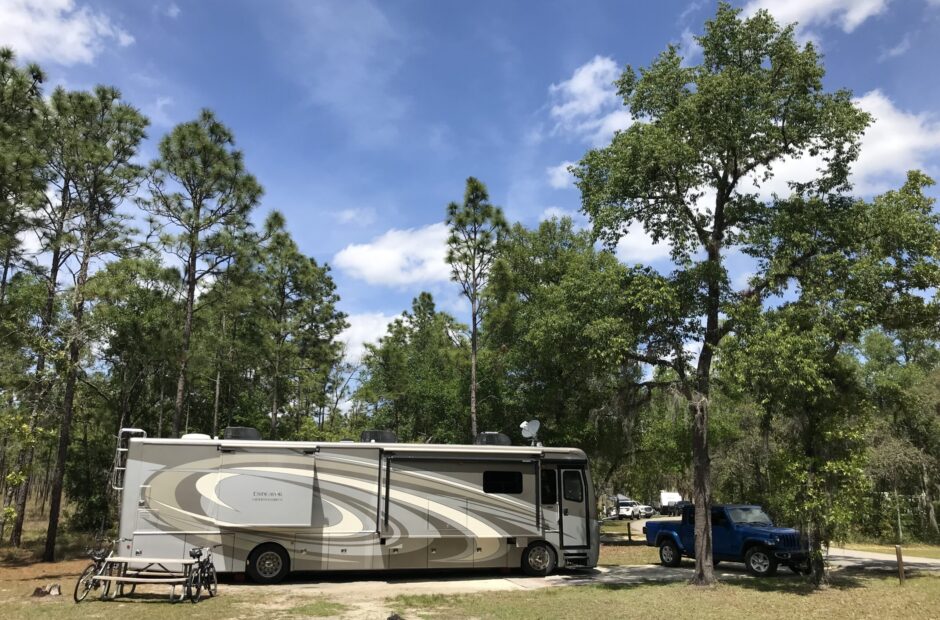(Per my mom’s suggestion and Blaine’s agreement, I’m going to start putting our destination on each post.)
Jekyll Island State Park, Georgia
The sun came up this morning and is shining brightly into our home and believe it or not, there’s still ice melting out of the trees!
The news is all agog about the weather. Remember interstate 95 where I was in the driver’s seat? It’s closed. And the last campground we were at? Givens Ferry? They got dumped on with 7.3 inches! One newscaster in Savannah was talking about trying to find something to get through the ice in the streets and all he could find was a putty knife. They just have absolutely nothing down here. The last measurable snowfall in Savannah was 28 years ago! But truthfully, it’s the ice and cold that’s the problem. It snowed, it wasn’t cleaned up, people drove on it, it turned to ice, it thawed a bit, it turned back to ice again overnight. It will be several days before they recover from this. And even longer for some schools as their pipes burst.
I forgot to mention in previous posts that they’ve been showing how to protect your pipes from freezing. We don’t get that kind of advice in Ohio. Makes us smile. 😊
We’re going out today! It’s supposed to get into the mid-40’s here on Jekyll, but very windy. Doesn’t matter to us. If we don’t get out and walk soon, I think we’ll both go stir crazy!
About 11am, we headed out with lunch in hand. As well as lots of layers! And our raincoats to use as a windbreaker. Turned out to be a great decision to take those along!
We were in the elements for about 3 hours. It took me 2 hours to thaw. I know it’s not all that cold – 38 degrees, but with winds whipping constantly between 25-30mph, it was COLD!
But we enjoyed being out immensely!
We visited Jekyll Island a few years ago and were looking forward to seeing Driftwood Beach again. The last time we were here, it was foggy and very eerie on the beach. We loved it! Immediately, we were struck with the fact that there weren’t nearly as many of these trees now thanks to Hurricane Irma. She scooped them up and threw them into the sea. Gone forever. ☹
But there were still enough to provide a glimpse of the beach’s former glory.
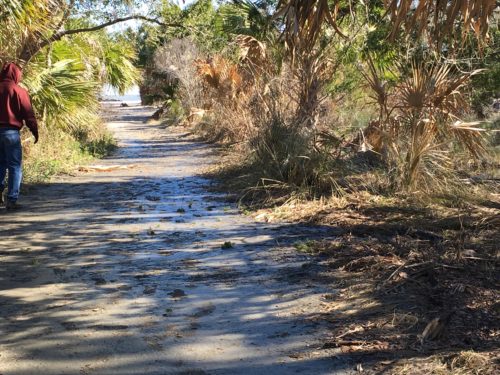
The path to the beach
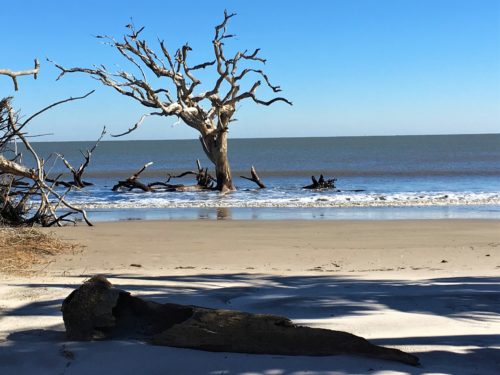
This is the first thing we saw when we came to the end of the path.
Pretty cool, huh?!?!?!
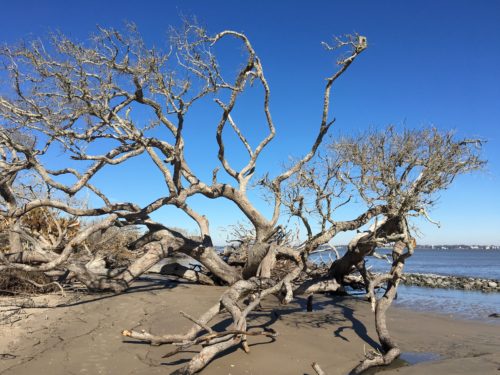
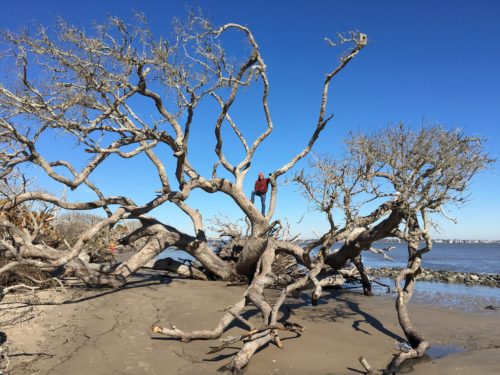
There are no cliffs here. He’s gotta climb something. : )
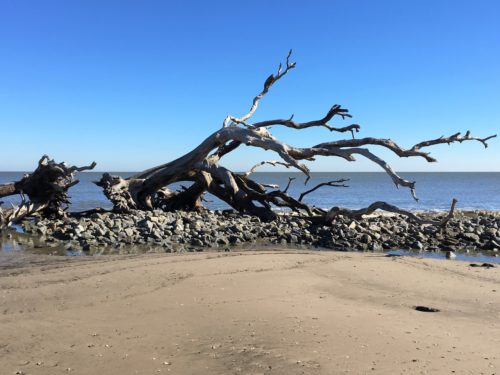
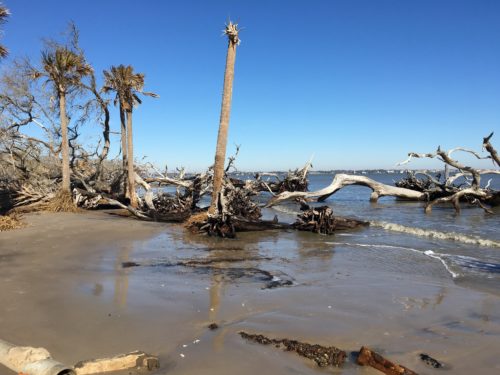
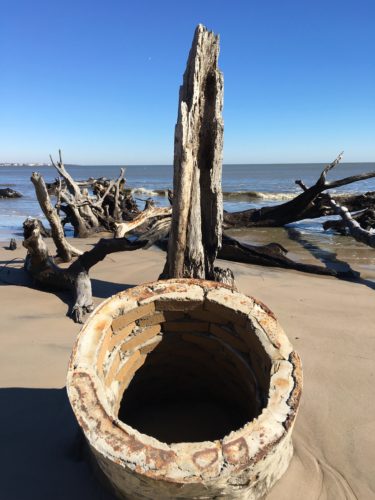
Evidence of Hurricane Irma
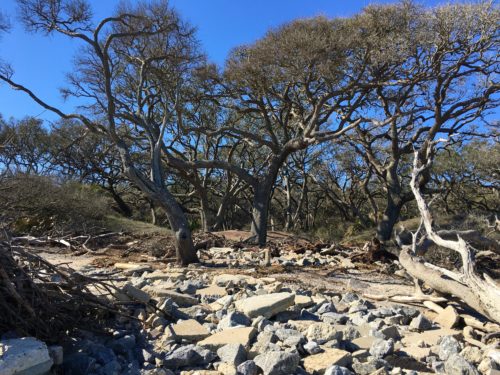
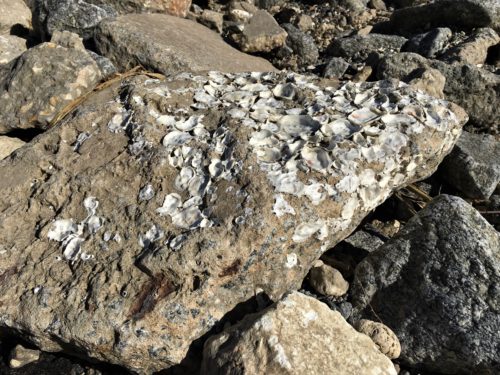
Evidence of Tabby building
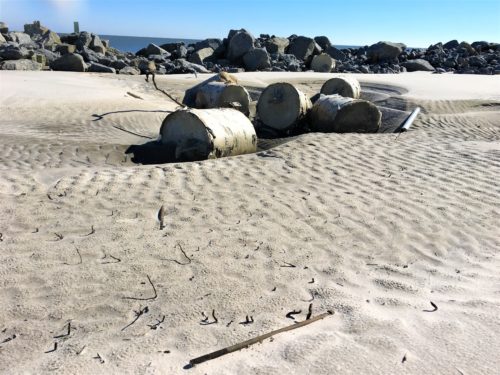
These are actually pieces of “sona tubes”. Blaine says they’re concrete supports for the piers that used to be here.
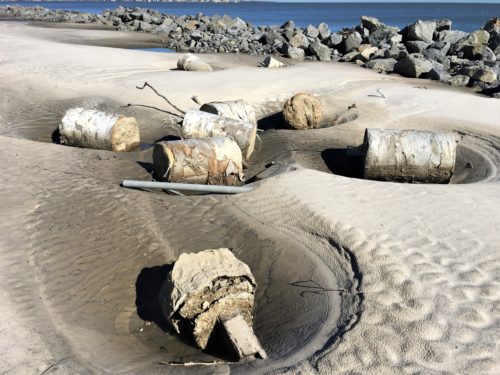
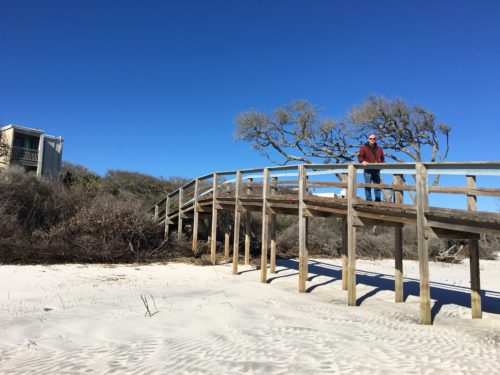
This boardwalk isn’t in use due to hurricane damage.
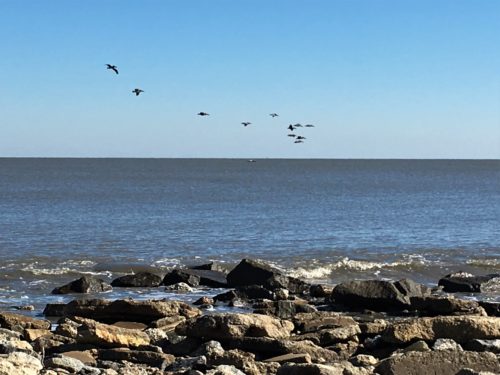
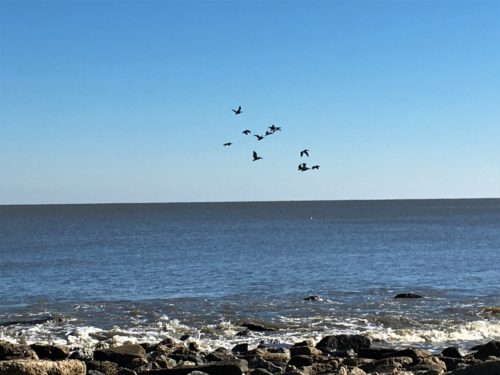
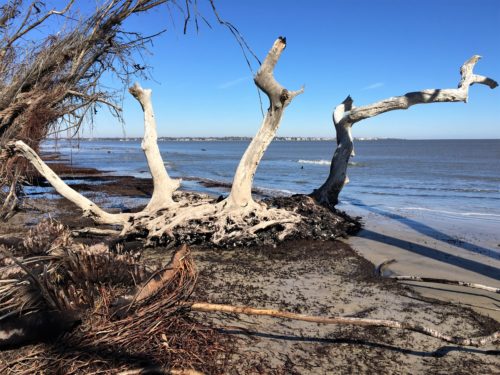
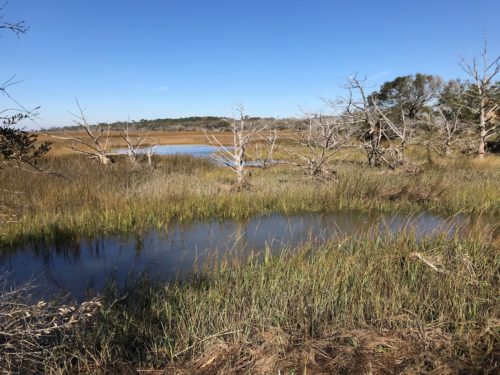
High tide in the marsh.
This is on the opposite of the beach.
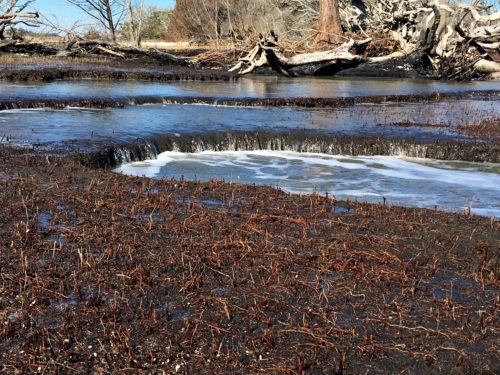
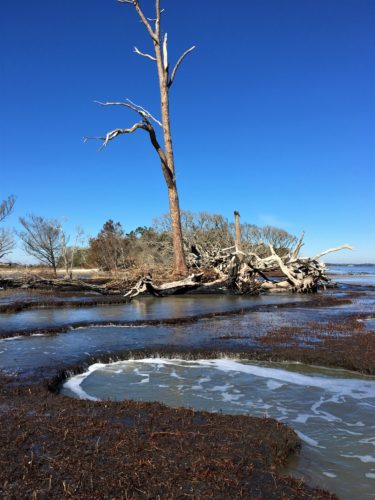
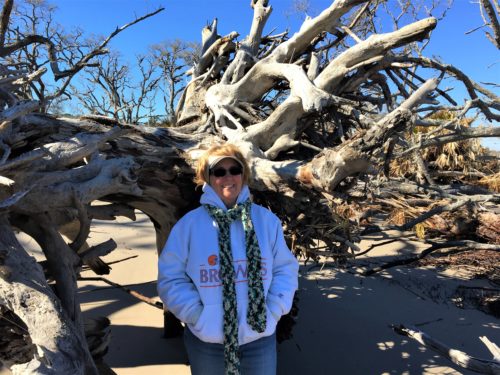
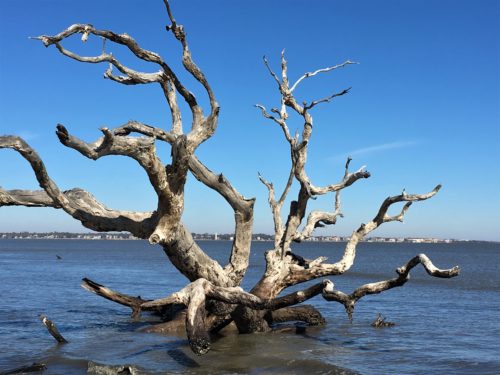
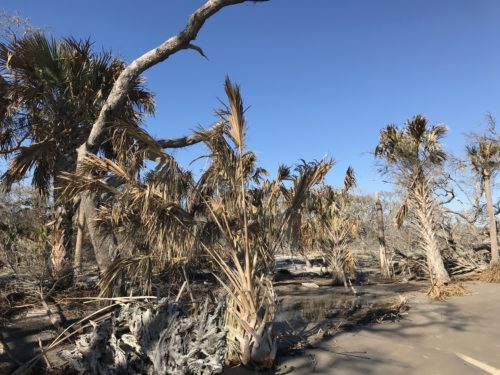
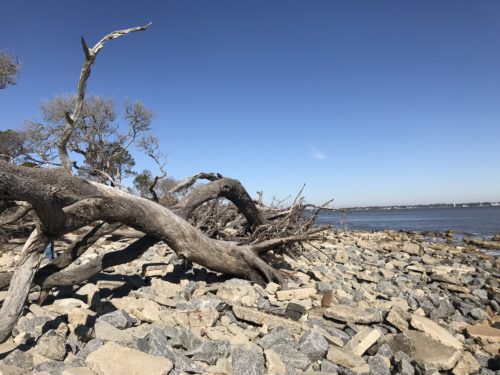
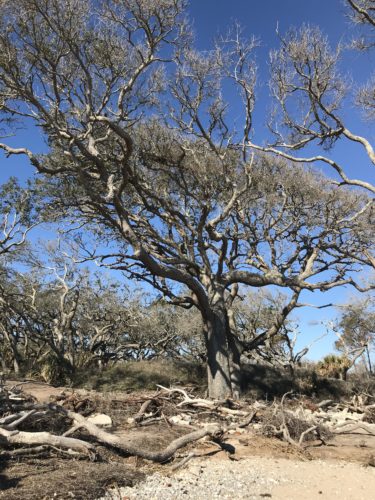
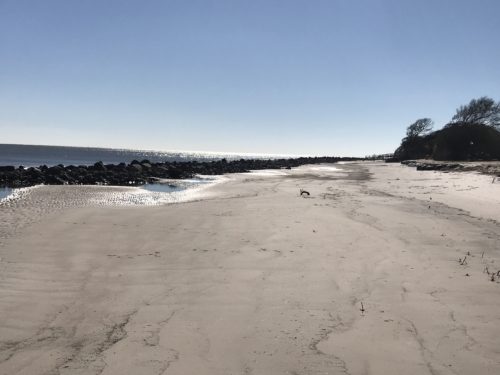
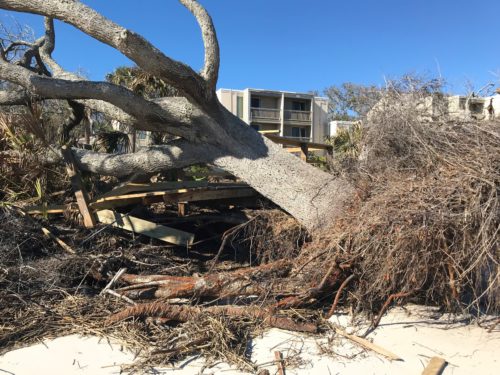
More evidence.

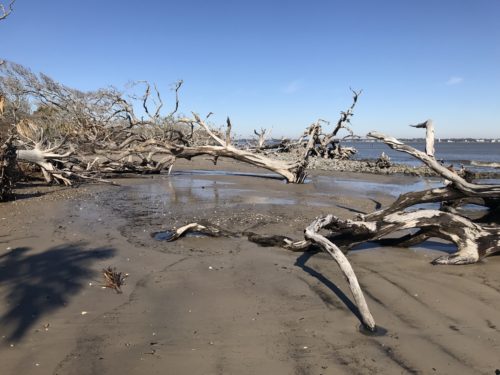
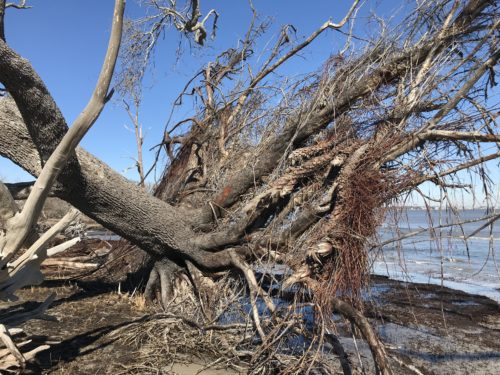
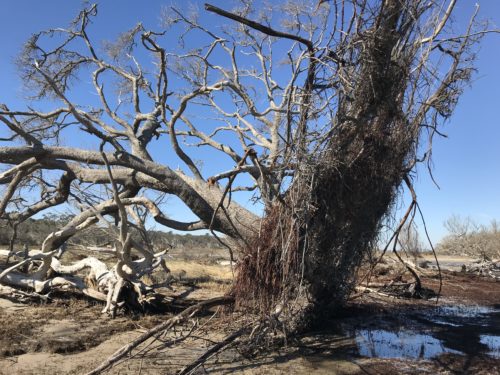
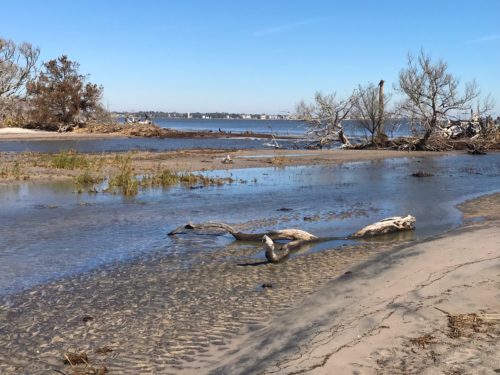
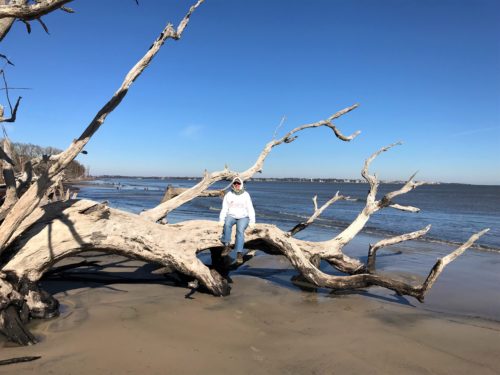
This is how I looked most of the day!
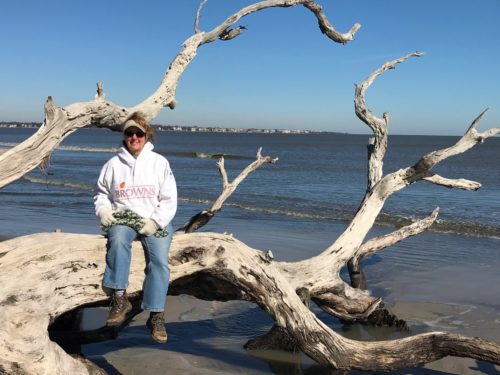
Blaine made me take my scarf off for the picture. : )
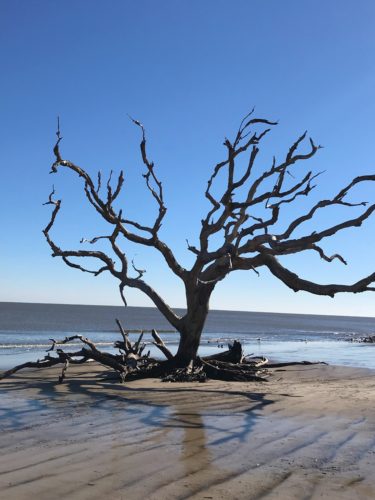
This is our same tree from the ‘dark side’. : )
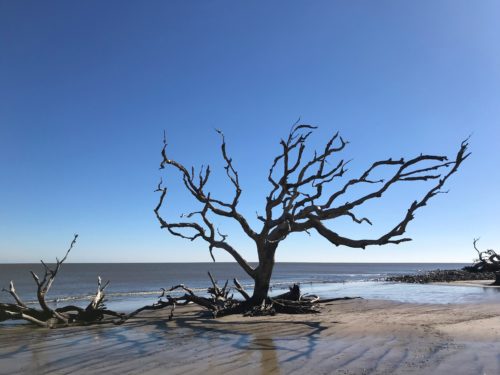
Once we’d see all there was there, we headed out to see the pier we’d found yesterday during our drive around. It was super cold here! Nothing to block the wind. There were beautiful picnic tables and a walking trail, but not today!
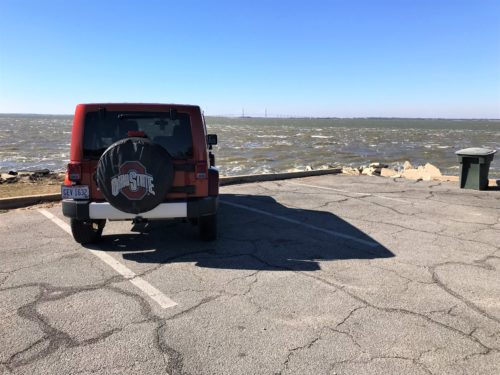
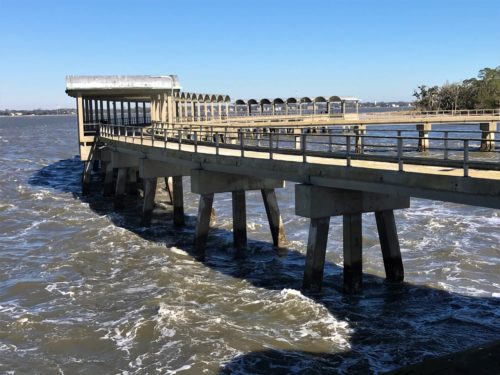
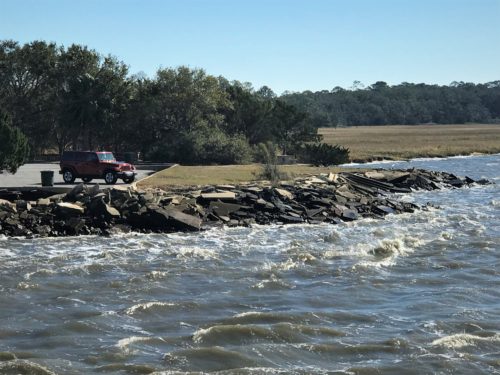
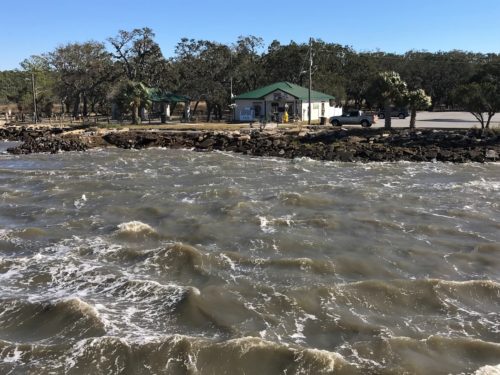


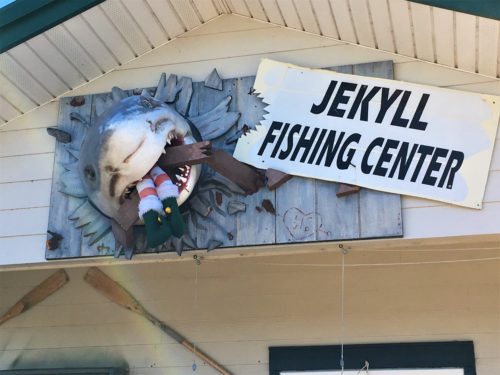
So THAT’s that happened to that elf!
We ate in the Jeep! With the heat on!
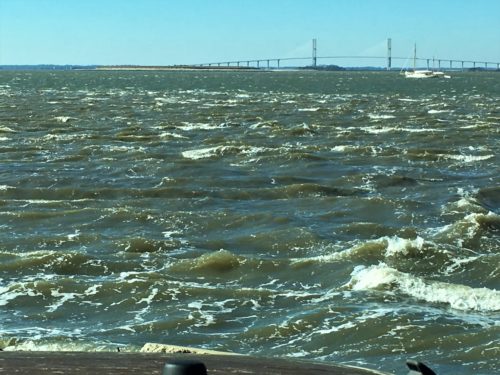
Lunch View
During lunch, we not only watched the churned up water, but there were some birds, similar to cormorants, fishing off the pier. They must have known how to navigate the swiftly moving water because they’d take off the pier to our right, fly past us and land in the water to our left. They’d careen “downstream” toward the pier before diving under to fish.
On the way to our next destination, we stopped by the Horton House.
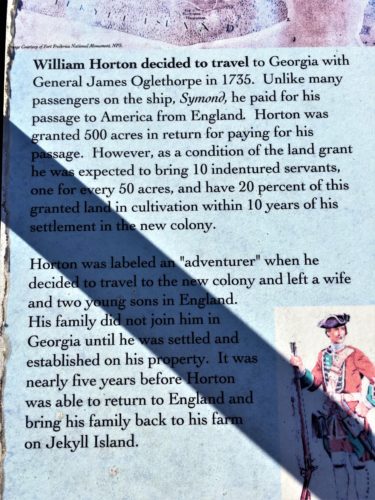
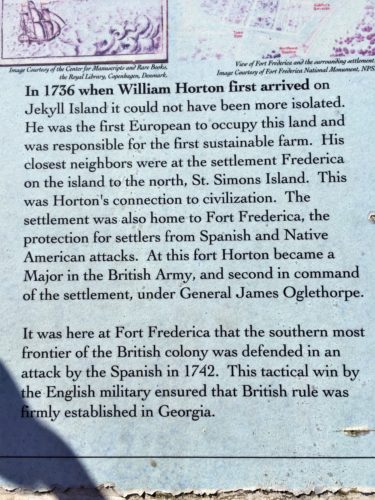
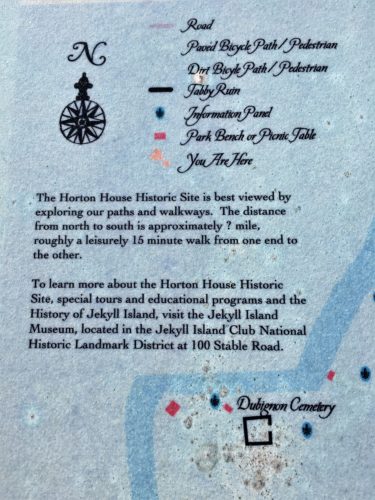
The question mark here caught my eye. : )
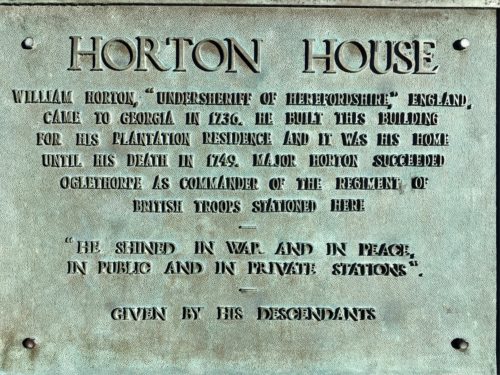
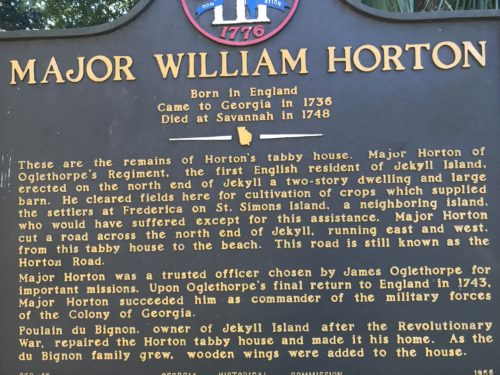
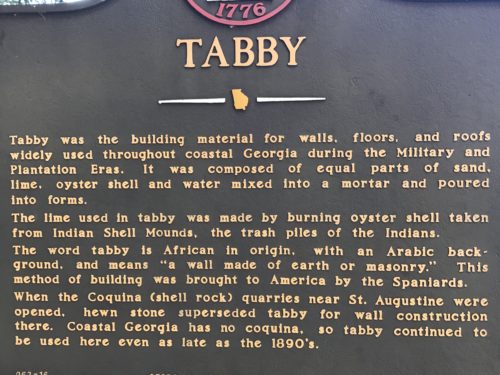
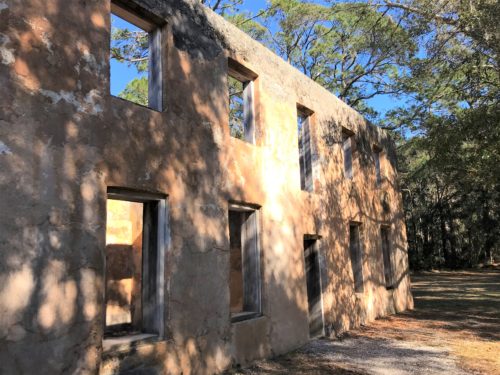
They sure built things to last 200-some years ago!
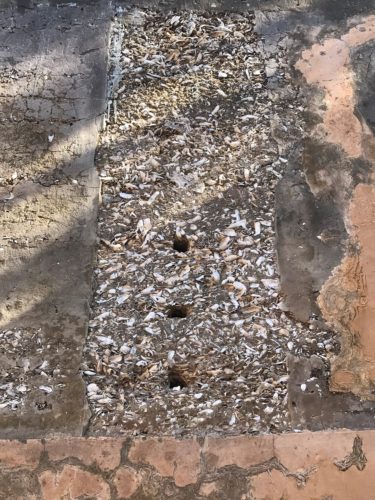
One of the walls inside
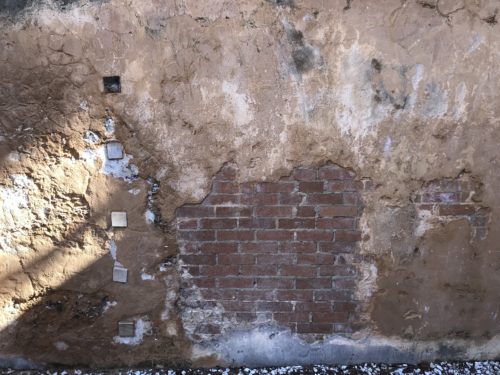
Another wall.
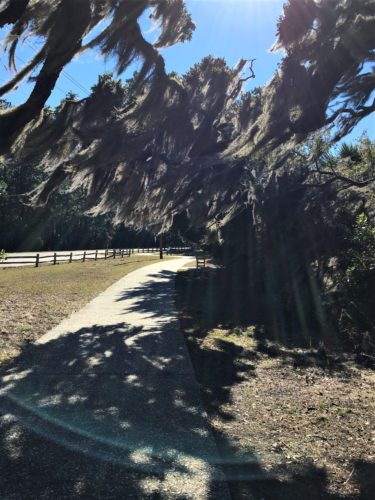
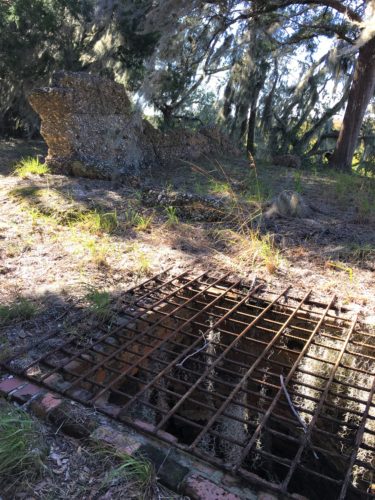
Remnants of a warehouse that used to be on the property.
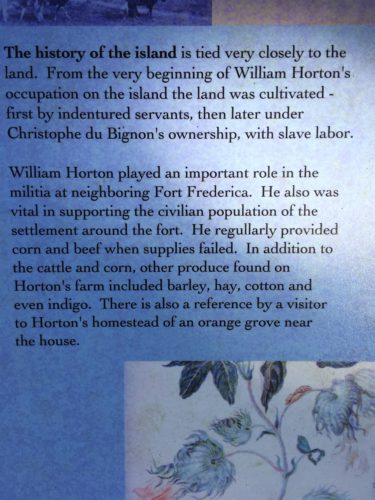
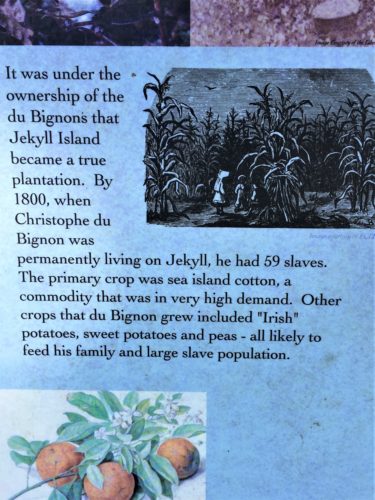
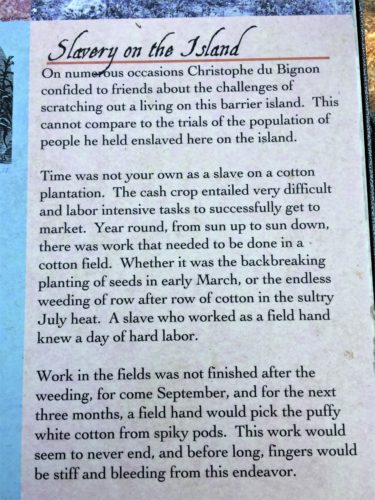
You have to speak with a French accent to gain full appreciation of this family. Oui?
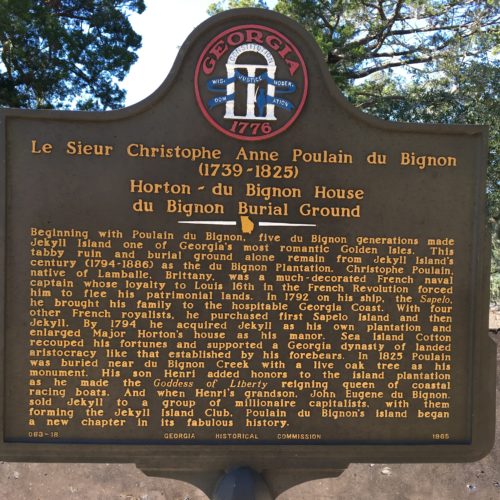
Later owners of the property.
They’re the ones who put in the burial plot.
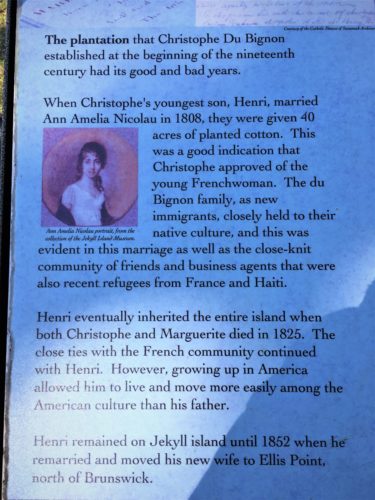
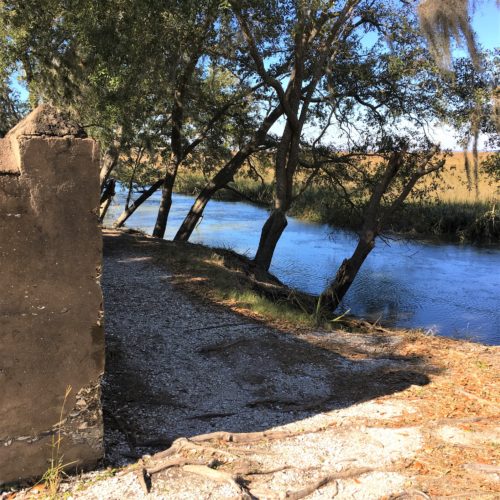
Quite a view for a burial plot.

The wall around the plots
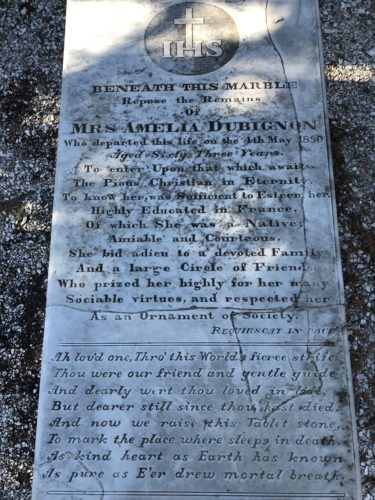
All three of these were quite elaborate.
There were two other markers that we couldn’t read except that both drowned on the same day.
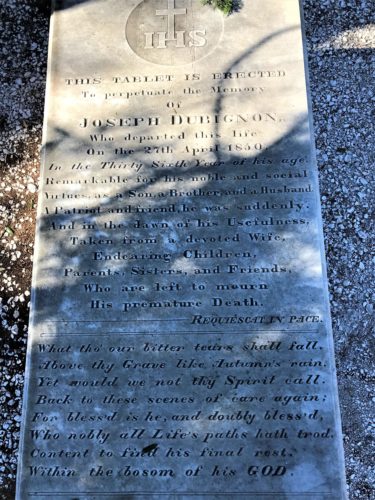
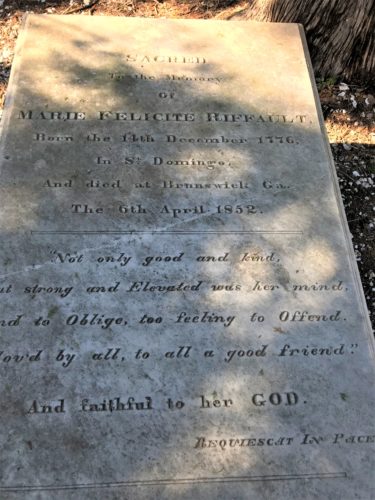
Our final stop was to the Jekyll Island Clubhouse to check out the cottages we remembered seeing before.
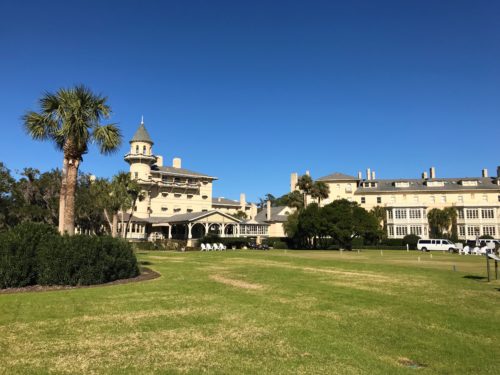
Welcome to the Jekyll Island Clubhouse and Annex.
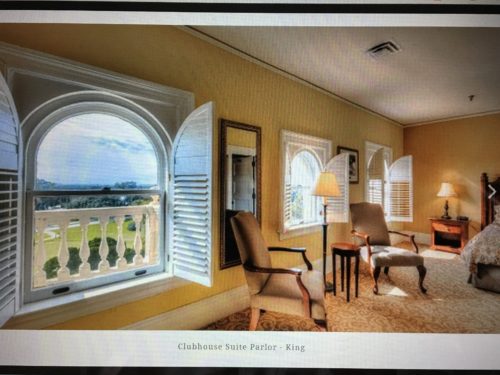
One of the rooms!
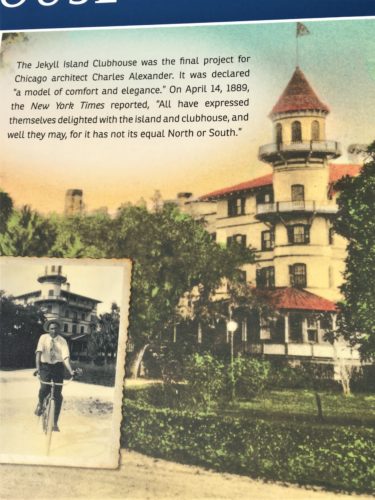
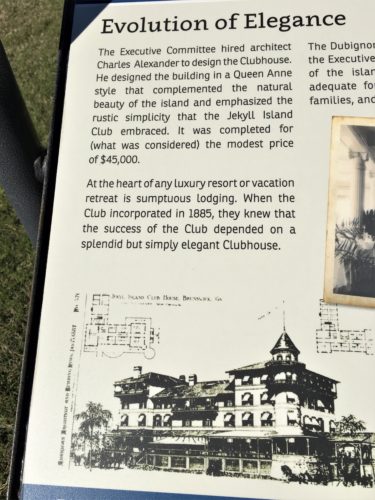
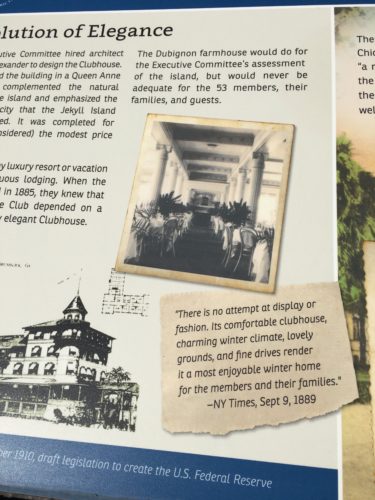
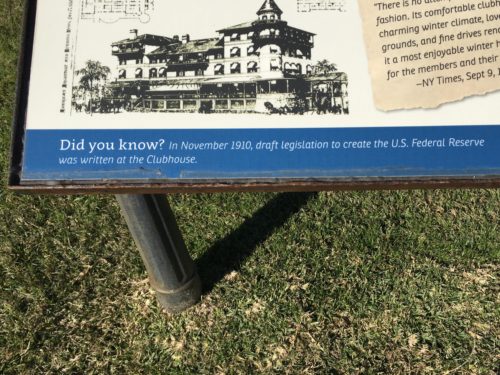
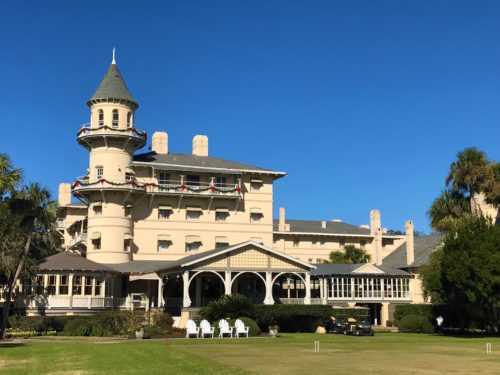
These are all restored homes and are open to the public for tours. The rooms in the hotel and apartment building are available for rent.
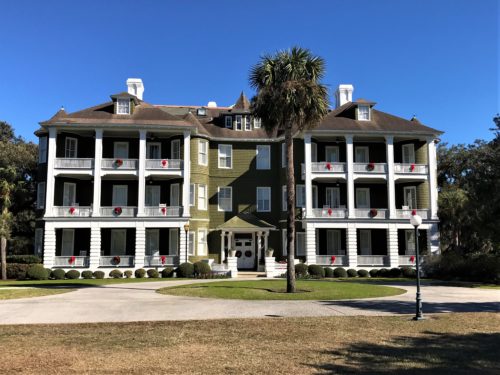
This was one of the first condominiums built in America!
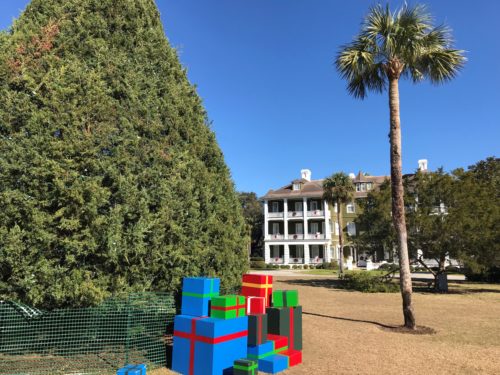
There’s still a little Christmas hanging around the Island!
A lot of history happened on this little island, which is has been a Georgia State Park since the 1940’s. The historic part of the island was named a National Historic Landmark in the 1970’s. Below are a few things I took off their website.
It started after the Civil War when a Confederate soldier named, Newton Finney (he served on Robert E. Lee’s staff at one point) approached his brother-in-law John Eugene Du Bignon (if you read the previous info, you’ll recognize this name.) He wanted to buy the island and open it for exclusive hunting for America’s “rich and famous”.
It was! And more!
In 1886, Jekyll Island was purchased to become an exclusive winter retreat, known as the Jekyll Island Club. It soon became recognized as “the richest, most inaccessible club in the world.” Club members included such notable figures as J.P. Morgan, Joseph Pulitzer, William K. Vanderbilt, and Marshall Field.
Members prized the island for its “sense of splendid isolation,” beautiful landscape, and moderate climate. Jekyll Island, with its cottage colony and clubhouse, was viewed as a little paradise, where members and guests pursued “a life of elegant leisure.”
Here, they enjoyed a variety of outdoor pursuits, such as hunting, horseback riding, skeet shooting, golf, tennis, biking, croquet, lawn bowling, picnics, and carriage rides. Today, the former Club grounds comprise a 240-acre site with 34 historic structures. The Jekyll Island Club National Historic Landmark is one of the largest ongoing restoration projects in the southeastern United States, attracting curious guests from around the world.
Here’s a history line I took from the website. The pictures were taken on my computer screen:
1733 – General James Oglethorpe founded the colony of Georgia and named Jekyll Island in honor of Sir Joseph Jekyll, his friend and financier from England.
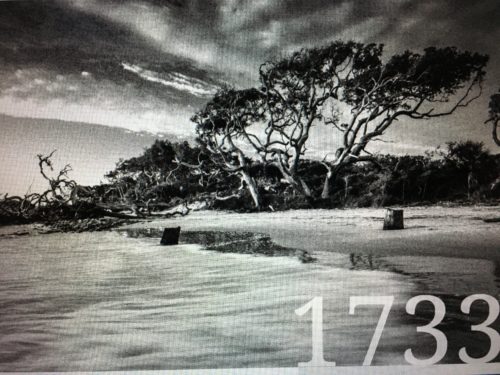
1736 – English, Spanish and Creek Indians met on the island in an effort to settle their differences through diplomacy. (No word on how successful they were. 😊 )
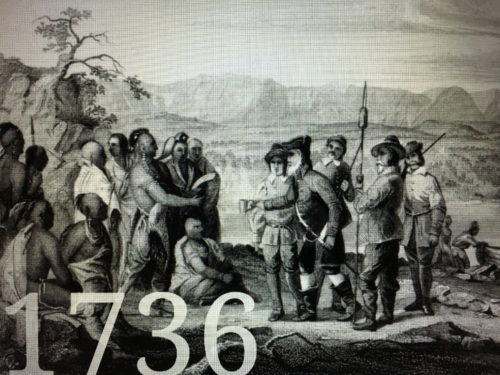
1747 – William Horton purchased a Great Copper Pot and began brewing beer on Jekyll Island at what would become recognized as the state’s first brewery.
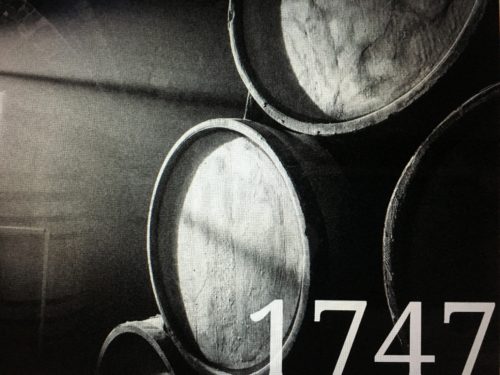
1792 – Fleeing the French Revolution, Christophe DuBignon purchased property on Jekyll Island.
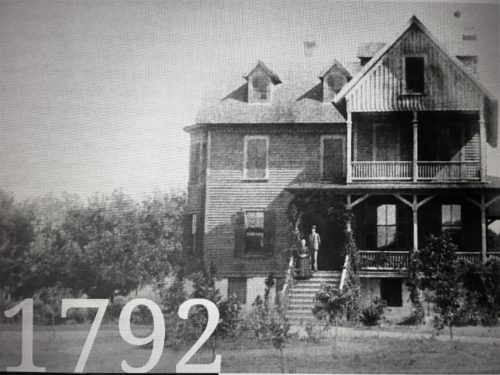
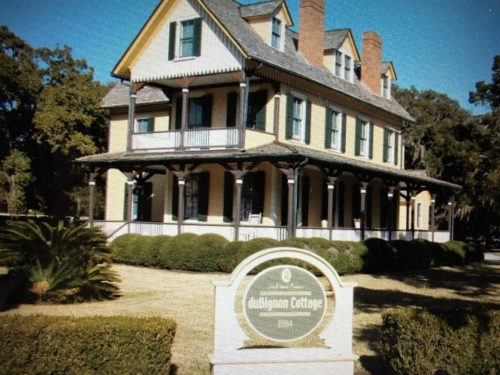
We didn’t see this one, but it’s important history, so I found a picture of it.
This is how the house currently looks.
1879 – Newton Finney, and brother-in-law, John Eugene Dubignon, a descendant of Christophe DuBignon, collaborate to turn Jekyll Island into a private hunting club for the nation’s wealthiest individuals, quickly becoming their winter hideaway.
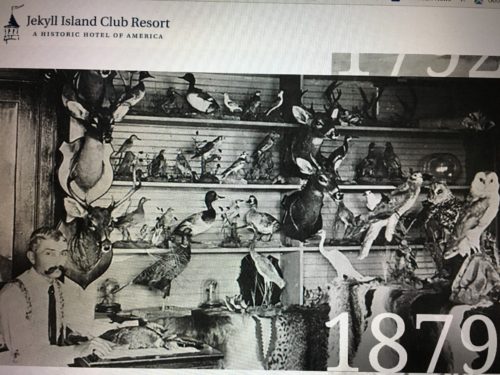
1886 – The Island was purchased by the newly formed Jekyll Island Club which Munsey’s Magazine called, “the richest, the most exclusive, the most inaccessible club in the world.”
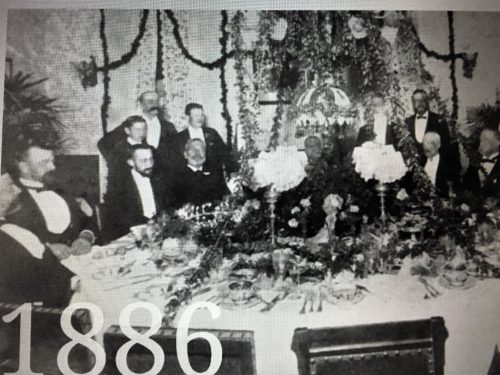
1888 – The Club officially opened its doors in January 1888, quickly becoming a retreat for families that represented one sixth of the world’s wealth.
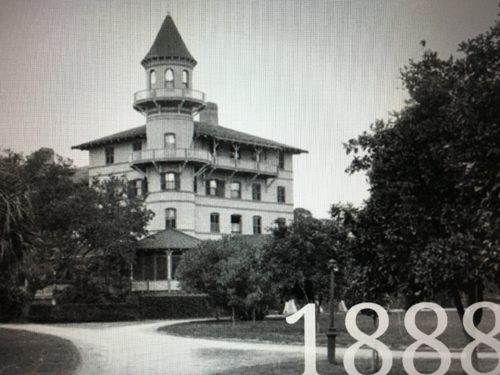
1896 – Sans Souci, owned in part by J.P. Morgan, this six-unit building is recognized as one of the first condominiums in the United States. The floors, leaded art glass, stairway and skylight are all original still today.
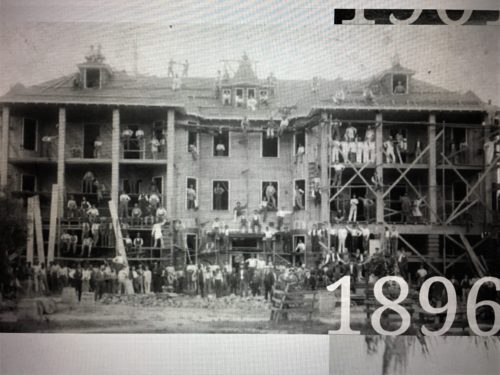
1901 – Built as an addition to The Clubhouse, The Annex featured eight suites for members and their guests on the first and second floors, some offering enclosed parlor rooms and river views.
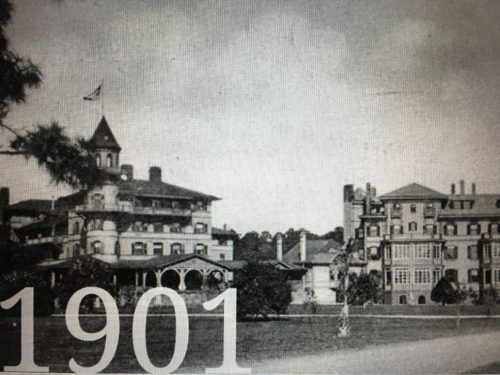
1910 – Under the cover of night, and using only first names to keep their identities secret, Senator Nelson Aldrich led a party of financial leaders to Jekyll Island to conceptualize a federal banking system. Coined the First-Name Club, together the group drafted the modern day Federal Reserve.
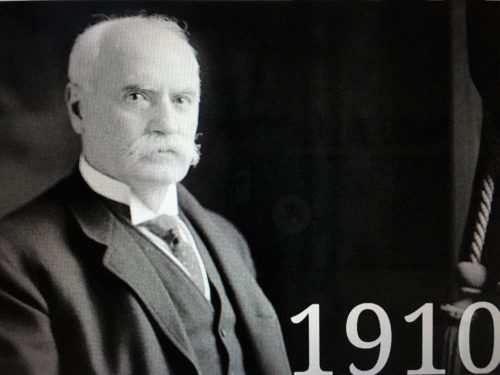
1915 – The nation’s first transcontinental phone call took place between President Woodrow Wilson in Washington, DC, Alexander Graham Bell in New York, Thomas Watson in San Francisco, Henry Higginson in Boston, and AT&T President Theodor Newton Vail at Jekyll Island Club.
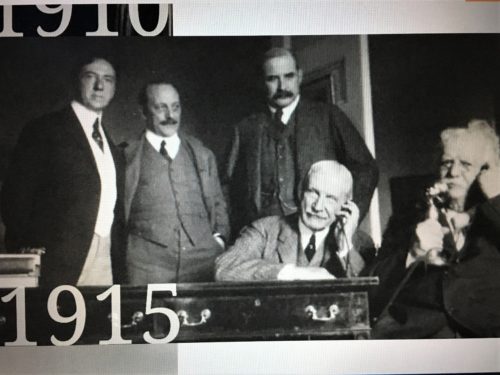
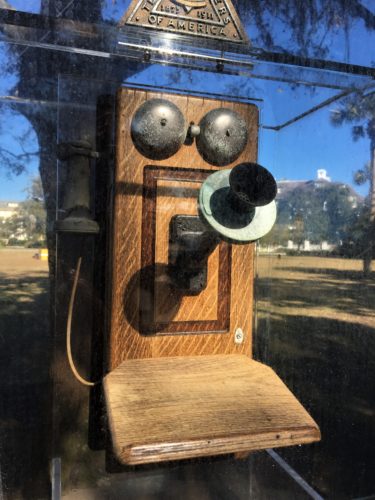
The plaque says it was a phone ‘of this type’.
Not the actual phone. I guessed that based on the picture they took. I’m not convinced it was this type either, unless the picture is staged . . . . .
Hate it when I start questioning history and/or people more knowledgeable than me . . . .
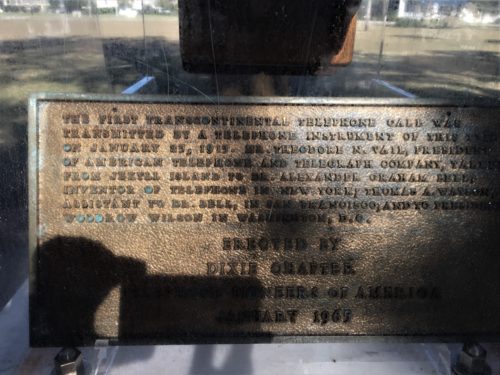
1924 – Even golf as we know it was shaped here. In 1924, the USGA selected Jekyll Island as a testing ground for golf, replacing hickory shafts with new steel clubs, and testing ball performance. Together these strokes of genius resulted in the use of a lighter ball and steel shafts, forever changing the game.
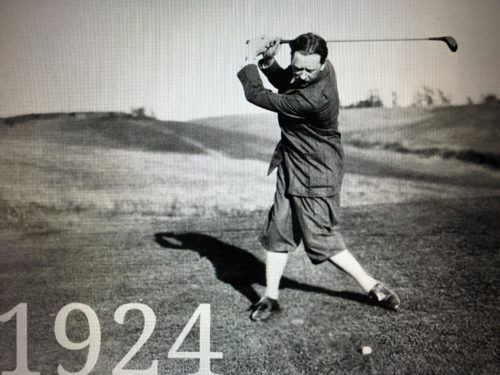
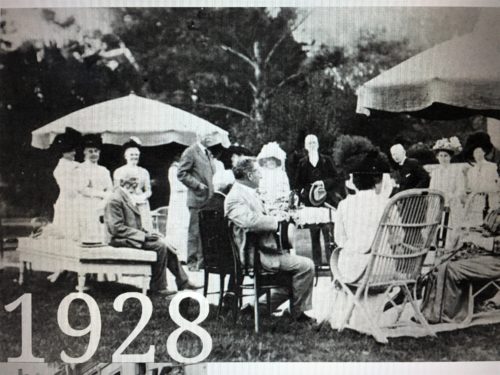
1942 – The Jekyll Island Club flourished throughout the 1930s, but world events took their toll. The Great Depression changed people’s priorities, and half of the Club’s membership dropped away. The final blow was World War II when the government ordered evacuation of the Island due to the threat of enemy submarines off the coast.
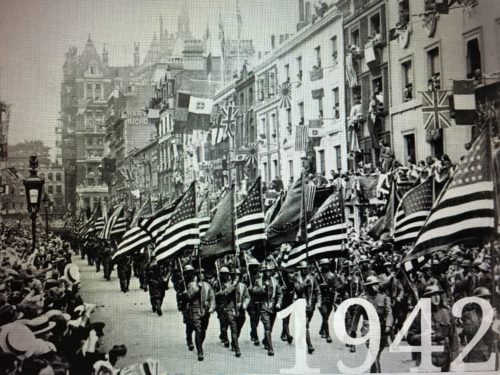
1948 – The State of Georgia purchased Jekyll Island from the Jekyll Island Club for $675,000. The Island opened to the public as a State Park in 1948.
1954 – The drawbridge to the Island opened and renowned curator and journalist, Tallu Fish, founded the Jekyll Island Museum. Operating out of Indian Mound Cottage, once owned by William Rockefeller, the museum featured Club-era furniture, a taxidermy display, a pottery exhibit and an ornate wishing chair.
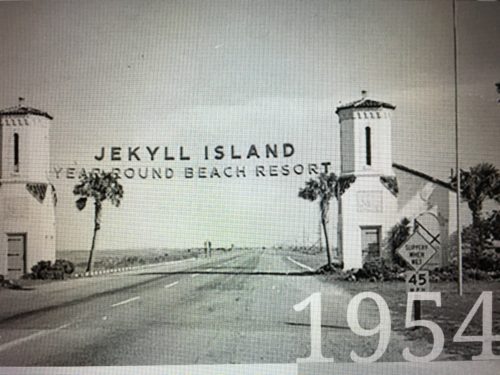
1978 – The historic district achieved Landmark District status, becoming known as the Jekyll Island Club National Historic Landmark District.
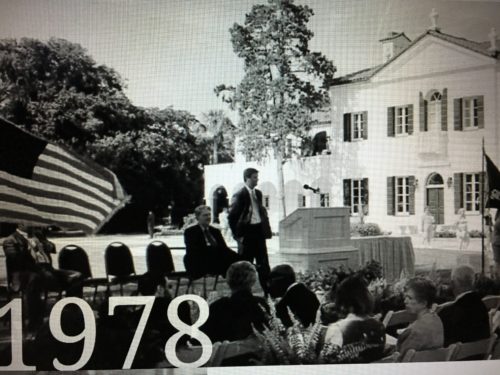
1985 – After a decade of neglect and abandonment, two friends, one a lawyer, the other an architect, climbed through an unlocked window and fell in love with the deteriorating Clubhouse. Together, they planned to preserve and renovate The Club to its original splendor and re-open it as a hotel.
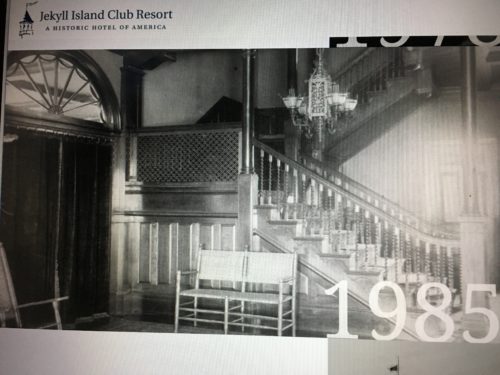
1987 – The hotel’s Grand Opening ceremony included remarks from Joe Frank Harris, Governor of the State of Georgia, and Paul Warwick, Mayor of Brunswick. The celebration included harp players and an ice sculpture in the form of The Clubhouse turret.
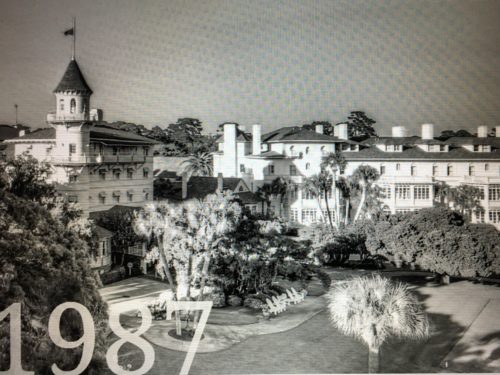
1999 – Robert Redford’s Legend of Bagger Vance starring Will Smith, Matt Damon, and Charlize Theron is shot along the Riverfront Lawn. Other notable films shot on Jekyll Island include X-Men:First Class, Glory and Live By Night
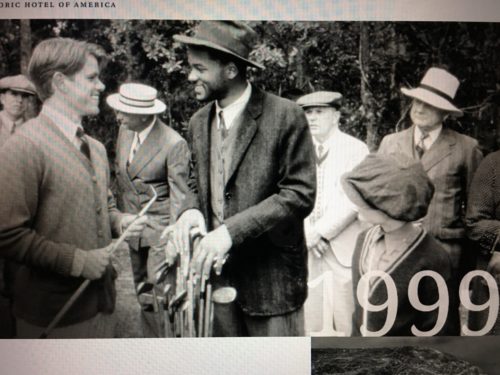
2007 – The Georgia Sea Turtle Center opened in the renovated power plant of the Jekyll Island Club.
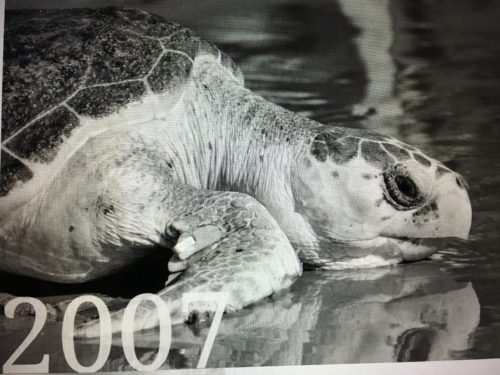
These are the cottages we visited:
DuBignon Cottage (As I mentioned above, we didn’t actually visit this one, but since the family is talked about a lot in this post, I thought I should include it.)
Built in 1884 by John Eugene DuBignon, this home was originally located on the site of Sans Souci, but was moved to its present location in 1896 in preparation for the construction of Sans Souci. Mules pulled the house with the help of skids and logs. The structure was lowered on to brick piers, lattice was added under the porch and the exterior color scheme was altered to make the porch posts and window trim considerably darker. Decorative brackets and gutters were also added. It is likely that the Club added numerous enhancements, including the addition of faux marble to the fireplaces and decorative scoring on the hallway and parlor floors.
Sans Souci (the big green house) This is the apartment I mentioned earlier
From its origins in 1896, constructed as a six-unit apartment building owned in part by J.P. Morgan, to its renovation and reopening in 1986, Sans Souci affords its guests effortless comfort, breathtaking elegance, and sophisticated detail. Its name connotes the carefree experience The Club members anticipated on Jekyll Island. Every effort has been made to preserve Sans Souci, considered among the nation’s first condominiums, right down to the fireplaces and winding staircase still in use today.
Goodyear Cottage
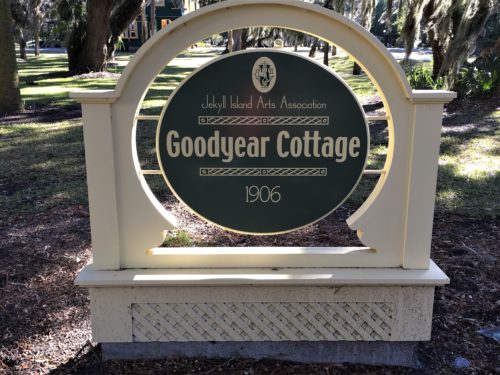
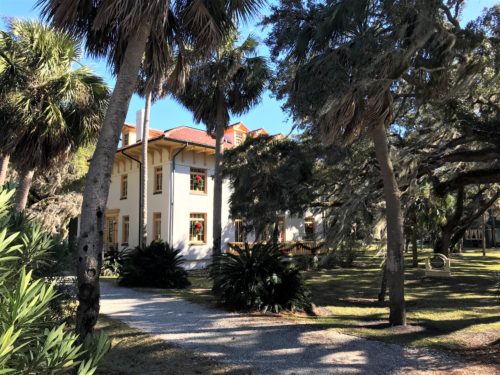
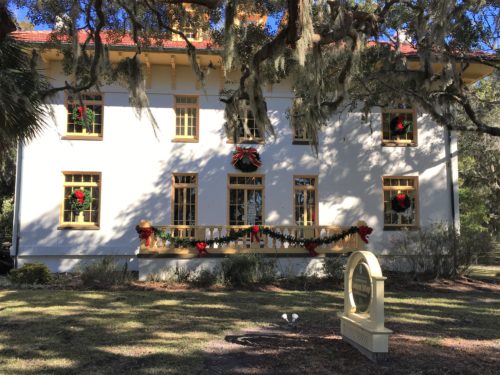
Architects John Carrere and Thomas Hastings of New York City designed this white stucco winter home, typical of Mediterranean Revival architecture. Their firm also designed the New York Public Library and the Ponce de Leon Hotel in St. Augustine, Florida. The cottage was built in 1906 for the lumber baron, Frank Henry Goodyear of Buffalo, New York. There are seven rooms and a half-bath on the first floor and five bedrooms and three baths on the second floor. The third floor originally contained a servant’s room, a bath, and a storage area. The house was restored in 1974 and is now used as a center for the creative arts, housing the Jekyll Island Arts Association and the Jekyll Island Pottery Guild. Exhibits by both local and visiting artists are on display monthly.
This house is the only one that had an information board out front.
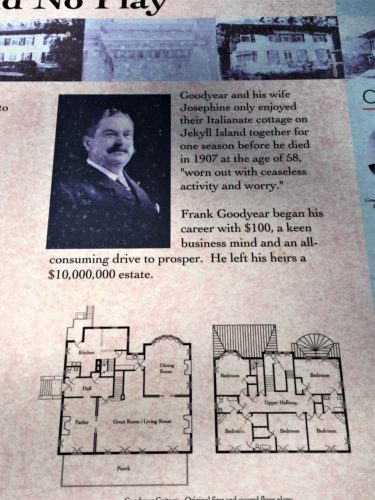
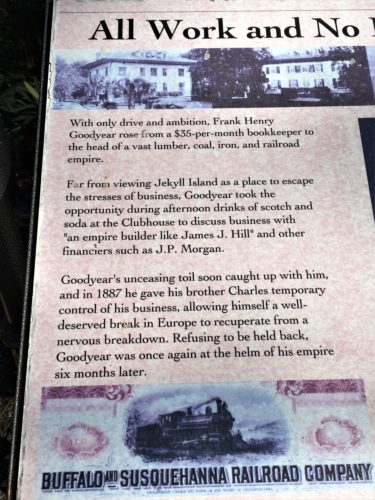
Despite the well known name, this gentleman is NOT related to the Goodyear Tire people.
Goodyear Tire was founded by Frank Seiberling in 1898.
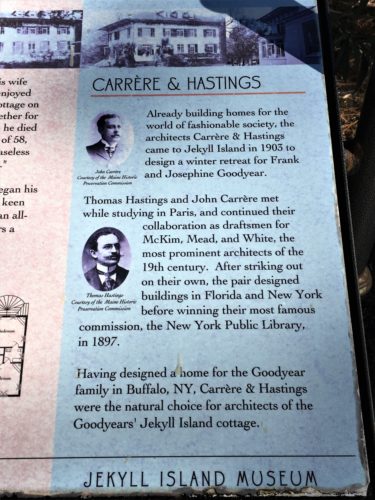
Indian Mound Cottage
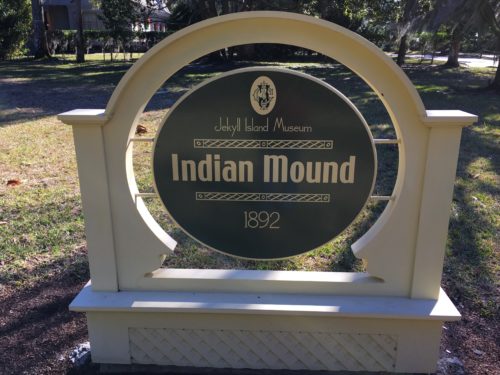
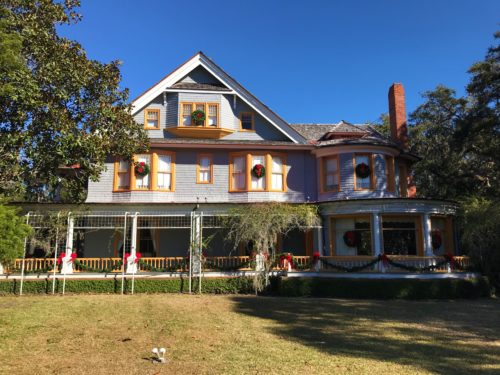
By the time the house was completed, six private cottages were listed on the Glynn County tax rolls for Jekyll Island. Included on the rolls were cottages built by McKay, Brown, Fairbanks, Maurice, Baker, and Furness. In addition, the main Clubhouse and several service buildings were extant.
Originally, McKay’s home looked very different, inside and outside, than it does today. It had only one public room, the parlor to the right of the front door. The remaining rooms were bedrooms, each with its own bath, which is why there is now the unusual feature of a bathroom opening onto the Reception Room. William Rockefeller made extensive changes to the house between 1912 and 1917:
- Added the porte-cochere or covered driveway
- Added dormers on the north façade
- Added the hand-operated dumbwaiter/baggage elevator and walk-in safe
- Changed columns on porches from Queen Anne to more classical Doric
- Changed windows on the west façade
- Extended living room and second floor bedroom with the large rounded bay addition
- Painted the natural woodwork of the house to a white paint
Rockefeller’s finished cottage included eight family rooms plus six servant/service rooms on the two main floors, in addition to servants’ rooms on the third floor. Rockefeller was also responsible for building the sea wall in front of his house in 1916.
Mistletoe Cottage
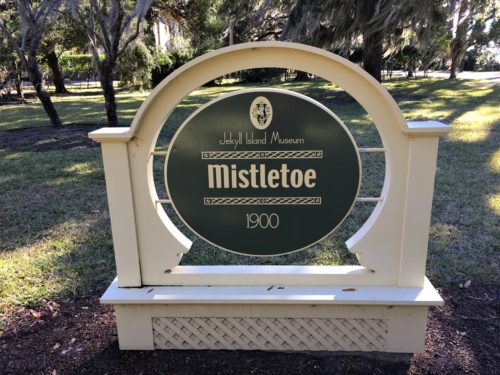
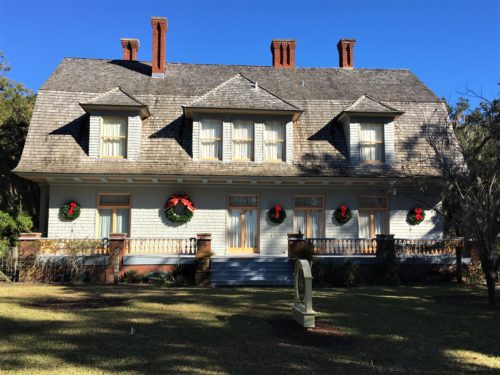
Architect Charles Alling Gifford designed Mistletoe Cottage. He worked with the architectural firm of McKim, Mead and White in New York City before opening his own firm there. The firm was the primary developer of the Colonial Revival and Shingle styles of architecture in the United States.
Gifford was best known as a designer of resort hotels, including Mount Washington Hotel in Bretton Woods, New Hampshire (which was owned by Club member, Joseph Stickney) and Clifton Hall in Niagara Falls, New York. He also designed the New Jersey State buildings for the World’s Colombian Exposition in Chicago in 1893, and the Louisiana Purchase Exposition in St. Louis in 1904.
Between 1896 and 1900, Charles Gifford was commissioned to design five buildings for the Club and its members. Gifford also designed the Glynn County Courthouse in a Beaux Arts style, which is quite different than the styles he utilized here on the island.
Moss Cottage
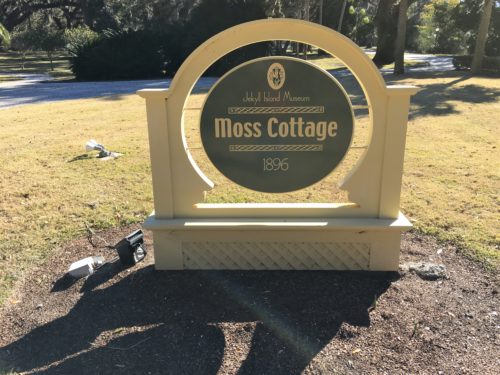
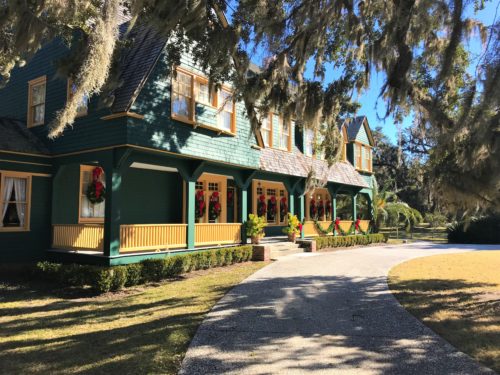
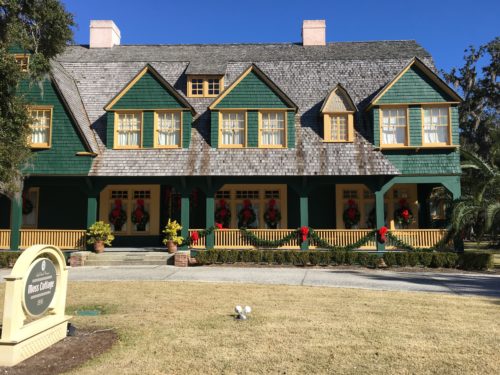
This cottage was built in 1896, as shown by the inscription in seashells on the front. Typical of the early club cottages, its rustic appearance is a reflection of the casual lifestyle of the original club members, who sought to escape from the pressures of the city to hunt, fish, and enjoy the natural beauty of the coastal environment. Downstairs are an entrance hall, a game room with wood shingle walls, a parlor, a dining room and servant’s area with butler’s pantry and kitchen. Upstairs are five family bedrooms, two full baths, one half bath and a servant’s room. The attic floor contains seven rooms, probably used as servants’ quarters, storage, and one bathroom. The cottage, like many built during the Club Era, also has a basement. Originally, a solarium was located on the south side of the cottage.
Hollybourne Cottage (We also didn’t see this one, but we did on our last visit. As I recall, it was in a fairly severe state of disrepair and we wondered about it then. This picture shows some of the work they’ve been doing in our absence.)
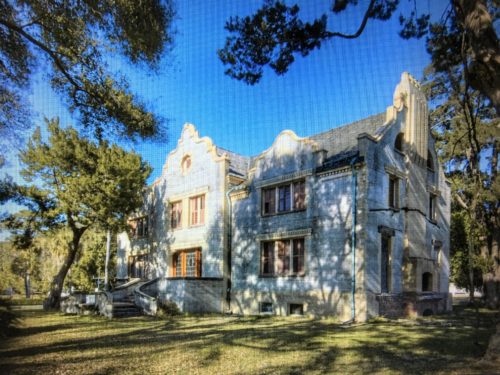
Hollybourne Cottage was built in 1890 by Club member Charles Stewart Maurice. Maurice helped to construct many road and railway bridges across the country. By the time Maurice retired in 1895, he had helped traverse many of the nation’s major waterways and had been instrumental in the construction of major landmarks around the country.
Hollybourne Cottage is one of Maurice’s many unique creations. The fabulous vacation retreat that Maurice built on Jekyll Island in 1890 was designed to be an architectural wonder of its own. The style was called Jacobethan or pseudo-Jacobean, and was an early example of an eclectic Tudor style popular from 1890 until 1940. The home features Flemish gables, paired chimney flues, and patterned stone work. It is the only home built during the Club era with tabby. The home was constructed with a steel support system, solid base of 19 brick piers in the basement, and a system of trusses to help distribute the weight and support the living and dining room ceilings without the use of beams.
In its original condition, the vacation retreat was a much-loved haven for Mr. and Mrs. Maurice and their nine children. The Maurice family made an annual pilgrimage to Jekyll Island, where they enjoyed a whirlwind of entertainments and explored the island’s simple pleasures.
Today, however, the cottage remains a diamond in the rough, with ongoing efforts to preserve the structure.
We back out in the evening hoping to see Christmas lights. The historic district still had lights up. No one turned them on. I guess it’s just too cold to take them down yet. We were disappointed.
Another cold night as outdoor temps dropped to 26 degrees. Blaine had to unhook the water again.
Tomorrow we move further south. Not by much, and not that it will matter. It’s looking like Monday will be the first day close to normal. Sure glad we brought winter coats with us!
TOTAL MILES: Maybe 2?
Year to Date: 2.75
